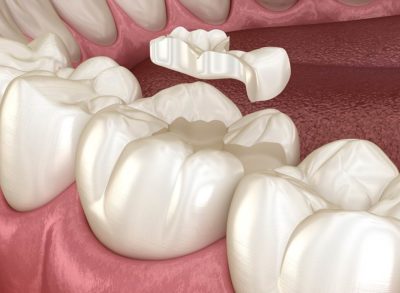Ceramic inlays stand for maximum aesthetics, longevity, and high compatibility. The consist of high performance ceramics and do not contain metal. You may hardly distinguish them from real teeth in colour since they exactly be matched to the colour of the tooth. The hardness of the used ceramics is matched to the enamel. Nowadays, no abrasion of counter-teeth will take place. First of all, this treatment type is appropriate for middle sized fillings but because its edge and dimensional stability also may be applied to stronger rundown teeth. For larger defects the teeth should be protected against further breaking by crowns.
Ceramic inlays over golden inlays have two substantial advantages:
- By the tremendous adhesive strength they provide to the teeth a really bonding
- Aesthetics – a ceramic inlay hardly may be distinguished from a natural tooth
Thanks the state-of-the art pressed ceramics technique the frequently used argument that too much dental substance has to be sacrificed may be rebutted.
Following an impression each ceramic inlay individually will be produced in the laboratory. For the demanding production and perfect processing, which is a prerequisite for the ideal fit and longevity, a specialist and huge dental expertise is required. Shape and size of the inlay must fit exactly since the opposite and neighbouring teeth could be impaired. The gap contacts should not be too weak since the food leftovers will be pressed into this area which could provoke a gum inflammation. Thus it is a real skill to produce fitting inlays as well as dental crowns and bridges. Using a special gluing technology (see also adhesive technology) under coffer dam insulation the ceramic inlay will be glued to the tooth. This approach enables a gluing technique with absolute dryness by the exclusion of humidity, including breathing. Only absolute dryness allows for a perfect and durable adhesive compound between the ceramic and the tooth. This needs precise working and skills since only perfect sealing zones complete gapless and tight. By the gluing a real reconstruction and stabilization of the tooth takes place and to lose it is almost impossible. Apropos: If a tooth will be filled with a ceramic inlay the after they eventually applied local anaesthesia subsided it can be immediately stressed again. Thus, after the treatment you will soon be able to eat.
5 Reasons for the Treatment with Ceramic Inlays:
- In the first place, a ceramic inlay is the most durable filling
- The ceramic inlay strengthens the tooth
- It is aesthetically sophisticated
- By ceramic inlays frequent drilling and therefore the loss of dental loss while the replacement of amalgam or plastic fillings will be avoided.
- From these results a reduction of the risk of a root canal treatment (but not for deeper decay near the dental nerve)-

